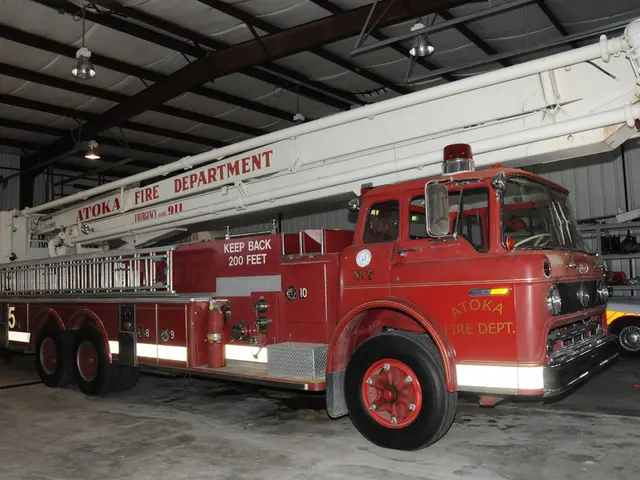Department of Defense to Incorporate Advanced Technology for Base Security and Multi-Drone Fleets
Fast-Track Defense Innovation: Rethinking Autonomous Systems and Space Control
pecial Assistant Secretary of Defense for Mission Capabilities Thomas Browning announced that the Pentagon is investing in new solutions for protecting remote bases, managing satellite operations, and enabling collaborative drone technology. This forward-thinking approach is led by the Office of the Under Secretary of Defense (OUSD) through the Rapid Defense Experimentation Reserve (RDER), a strategic program launched in 2021 to expedite the development of cutting-edge defense technology.
Through RDER, prototyping and experiments will be funded for technologies that could potentially become programs of record, addressing unsolved issues identified by Combatant Commands. This program's primary focus is on technologies that fall into the gaps and haven't been accounted for with existing solutions. Heidi Shyu, undersecretary of defense for research and engineering, spoke about its significance shortly after its inception, noting that it filled a COCOM's (Combatant Command) capability shortfall at the joint level for the first time.
While most projects undertaken by RDER remain classified, Browning did share that the projects focus on specific missions or challenges within two-year classes. The first class centered on long-range fires for the Pacific, with 23 projects initiated. Four of these projects successfully transitioned to the services and will become programs of record, and another dozen or so are still in contention. Browning mentioned that around six projects are unlikely to transition right away, but the Senate Appropriations Committee wasn't as optimistic, criticizing the program for failing to transition enough projects in 2023 and suggesting budget cuts for RDER in the 2025 defense spending bill.
Looking ahead to 2025, the program will take a comprehensive approach to the INDOPACOM (Indo-Pacific Command) battlefield, focusing on disrupting adversary kill chains and ensuring U.S. combat effectiveness. In 2024, RDER focused on underserved categories, including contested logistics and base defense, gaining valuable input from the J4, where logistics often aren't even considered during discussions.
The Air Force, particularly Air Mobility Command, emphasizes the importance of base defense and logistics support in the event of a conflict with China. To address these concerns, the Air Force is working closely with the Army to coordinate air defense assets. Looking forward to 2026, RDER is poised to focus on space control and support for the terrestrial fight, as well as autonomous collaboration.
An essential aspect of RDER's future initiatives involves ensuring that collaborative autonomous drone systems are resilient and effective against advanced threats from competitors like China. Additionally, the program plans to focus on autonomous systems that operate independently of human interaction, a technology often referred to as drone swarms. These swarms could be highly effective at disrupting base operations or shutting down airports.
On the other hand, RDER will look to collaborate with Space Force initiatives to coordinate drones effectively, addressing challenges related to avoiding self-destruction or interfering with each other. The Air Force is also making significant strides in this area through its Collaborative Combat Aircraft program, which aims to develop airborne platforms that team with manned planes.
In addition to autonomous drones, RDER is closely tied to space control efforts, despite not explicitly being focused on space-based technologies. The broader defense innovation ecosystem is developing next-generation sensor networks, space-based ISR systems, and advanced interceptors for missile defense initiatives such as the "Golden Dome."
Given RDER's focus on rapid experimentation and alignment with broader defense modernization priorities, the coming years promise to be exciting as the program moves forward with its plans to revolutionize autonomous systems and space control technologies.
- The Pentagon is investing in defense solutions that involve protecting remote bases, managing satellite operations, and enabling collaborative drone technology, as announced by Special Assistant Secretary Thomas Browning.
- Heidi Shyu, undersecretary of defense for research and engineering, noted that the Rapid Defense Experimentation Reserve (RDER) filled a COCOM's (Combatant Command) capability shortfall at the joint level for the first time.
- In 2024, RDER focused on underserved categories, including contested logistics and base defense, gaining valuable input from the J4.
- Looking ahead to 2026, RDER is poised to focus on space control and support for the terrestrial fight, as well as autonomous collaboration.
- An essential aspect of RDER's future initiatives involves ensuring that collaborative autonomous drone systems are resilient and effective against advanced threats, such as those from China.
- The broader defense innovation ecosystem is developing next-generation sensor networks, space-based ISR systems, and advanced interceptors for missile defense initiatives, with RDER being closely tied to these efforts.




